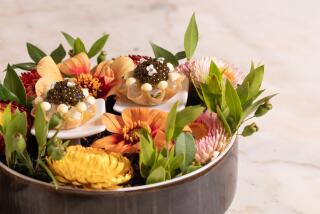They Know Their Duck at Eccentric Les Pyrenees
“What’s French food?” asked the young woman intently.
What’s French food! How could I tell her?
Twenty or even 15 years ago, French food might have been a battery of techniques and a repertoire of classic dishes . But it was far more: a unique window on food as an art form, almost a privileged state of being. Americans went starry-eyed over French wine and passed around actual French cheese like a sacrament. For restaurants, being French was something to aspire to.
Then we heard rumblings of what was being called nouvelle cuisine, and it turned out a lot of hot young chefs in France were actually tired of the classic dishes. They wanted to enrich the French tradition with Italian and Japanese elements. Once we got over the shock of thinking French tradition could be enriched, the idea made perfect sense--we are, after all, a land of immigrants. Furthermore, in California, we had a lot more cuisines at our doorstep than just Italian and Japanese, so we started inventing dishes like mad, though still mostly using French techniques.
And after a while, French restaurants as such seemed to fade from sight. I couldn’t even think of the last French restaurant I’d been in, and now I was at Les Pyrenees, which is precisely what we thought of as a French restaurant in Los Angeles not so long ago. It’s a light, dainty room with lots of mirrors, presided over by a maitre d’ who tickles every table of diners in turn with Gallic wit and charm. He’d be at our table any minute, and I had to explain French food to the intent young woman and her friends pretty fast.
“Well,” I began, “French food is what they eat in France. Let’s see: snails, frog’s legs. . . .”
“ Eeoo. “
“How about if I just order for us?”
Onion soup was no problem; she knew onion soup, though she’d have preferred more cheese on it. In fact, it was excellent, and I was glad it wasn’t a floating cheese pizza. The soup of the day was a simple, old-fashioned lentil with wine, carrots, onions and bits of ham, also very good, neither too thick nor too soupy.
The appetizers tend to be extremely old-fashioned, in fact. I’d already tried the mushroom caps--plain mushrooms, nothing Japanese--stuffed with crab, bread crumbs, garlic and parsley in lots of butter. The salmon mousseline was a big hit with the intent young woman’s neighbor, though I found the light texture of the salmon fluffs a little floury, and the hay-sweet lobster sauce the best part of the dish.
The liver pate she found ultra-familiar, and the escargots she tried with an unconvincing air of martyrdom. There was no doubt, though, about the best of the appetizers: a special that the charmingly Gallic maitre d’ had pushed, of particularly sweet and tender mussels in cream sauce.
The entrees are the very ones I used to see all the time on California French menus. New York steak with a simple--perhaps a little too simple--red wine sauce. Boneless double chicken breast with an excellent Madeira sauce, mostly meat glaze without an overbearing presence of the wine. Tender chunks of venison in wine sauce with green peppercorns (well, maybe not that old-fashioned: a dish of the late ‘70s maybe). At lunch I’d had a thin-sliced pork loin in a thin cream sauce full of whole-seed mustard.
Les Pyrenees does have two eccentricities: a habit of serving two silver dollar-sized pancakes with every entree, and a monomania for duck. You can get duck with the classic orange or cherry sauces (a bit on the sweet side, as California French restaurants learned Americans like it), and also with raspberry (also sweet, but not at all crazy), honey (rather sweet and medieval-tasting), blueberry (too sweet) and green peppercorn (not sweet at all). They know their duck here; the skin is adequately crisp and the meat not dry.
Nobody was puzzled by the soft raspberry cheesecake, the mocha genoise cake with coffee butter-cream filling and dark chocolate on top, or the brownie-like flourless chocolate cake. The marzipan tart was a lot better than it sounds, the marzipan less dry than you might fear and neatly counterpointed with bits of apricot. The best of the desserts was a lemon meringue tart with an elegantly thin filling and handsomely shaped curls of meringue on top.
Throughout the meal, my young guests studied everything as an exoticism, but at the end they seemed to conclude that French food wasn’t that exotic after all. In effect, they’d had bits and pieces of this meal as California cuisine.
Ah, but not all in the same place, right? And without the Gallic wit and charm, right? That’s the difference; that’s what French food is. These days, anyway.
Recommended dishes: onion soup, $5.50; duck with raspberry sauce, $16.75; lemon meringue tart, $5.
Les Pyrenees, 2455 Santa Monica Blvd., Santa Monica. (213) 828-7503. Open for lunch 11:30 a.m. to 2 p.m. Tuesday through Friday, dinner 5:30 to 10 p.m. Tuesday through Sunday. Full bar. Street parking. American Express, MasterCard and Visa accepted. Dinner for two, food only, $53 to $64.
More to Read
Eat your way across L.A.
Get our weekly Tasting Notes newsletter for reviews, news and more.
You may occasionally receive promotional content from the Los Angeles Times.










